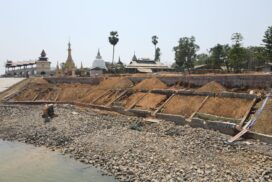Myanmar hosts 3.3 per cent of the world’s mangrove forests, covering 5,029 square kilometres, making it the seventh-largest mangrove country globally and the third in Southeast Asia. These mangroves offer numerous benefits, including food, water resources, medicinal plants, timber, and firewood. They also play a crucial role in environmental conservation by preventing landslides, enriching soil, and sustaining biomass.
World Mangrove Day, observed on 26 July each year, was established by UNESCO during its 2015 General Conference to highlight the importance of mangrove ecosystems. This day promotes the conservation and sustainable growth of mangrove forests, which are essential for human society and wildlife habitats.
More than 15 million hectares of mangrove forests are located in global countries, but only 1-2 per cent of them are lost on a yearly basis. As such, it is necessary to nurture and conserve mangrove forests as part of saving the lives of humans and animals relying on mangrove forests and improving the natural environment.
Mangroves thrive in tropical and subtropical coastal areas, enduring high salinity, tidal flooding, and low oxygen levels. Only 110 species are classified as mangroves due to their unique adaptation to saline swamps. These trees have complex root systems that help them withstand tidal waves and provide habitats for various organisms, including fish and crustaceans.
In Myanmar, mangroves primarily flourish in Rakhine State, the Ayeyawady Delta, and the Taninthayi Region. Despite their importance, the area covered by mangrove forests has been declining. Currently, Rakhine State retains 76 per cent of its mangrove forests, the Ayeyawady Region 29 per cent, and the Taninthayi Region 98 per cent, resulting in 66 per cent mangrove coverage nationwide. Among 110 mangrove species worldwide, 54 are considered actual mangrove plants, with 32 species found in Myanmar.
Conserving mangrove ecosystems is vital for preventing coastline erosion, mitigating the impacts of tides and tsunamis, and reducing atmospheric carbon. A significant example of their importance is the 2008 Cyclone Nargis, which devastated Yangon Region, Ayeyawady Region, and parts of Mon State. Despite the destruction, some individuals survived due to the protective barrier provided by mangrove forests. This event underscored the need for mangrove conservation, prompting successive governments and relevant authorities to prioritize protecting and restoring these crucial ecosystems.
By conserving mangrove forests, Myanmar can enhance its natural environment, protect biodiversity, and safeguard coastal communities from natural disasters. Mangrove conservation efforts contribute to a healthier, more sustainable environment, benefiting both human and wildlife populations.
More than 15 million hectares of mangrove forests are located in global countries, but only 1-2 per cent of them are lost on a yearly basis. As such, it is necessary to nurture and conserve mangrove forests as part of saving the lives of humans and animals relying on mangrove forests and improving the natural environment.












